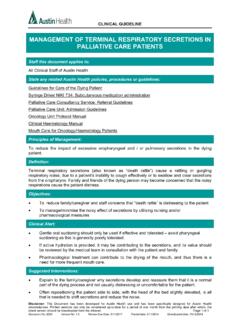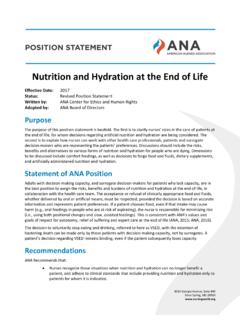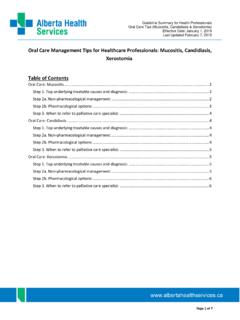Transcription of Review Diagnosis and management of Duchenne muscular ...
1 Review Diagnosis and management of Duchenne muscular dystrophy, part 1: Diagnosis , and pharmacological and psychosocial management Katharine Bushby, Richard Finkel, David J Birnkrant, Laura E Case, Paula R Clemens, Linda Cripe, Ajay Kaul, Kathi Kinnett, Craig McDonald, Shree Pandya, James Poysky, Frederic Shapiro, Jean Tomezsko, Carolyn Constantin, for the DMD Care Considerations Working Group* Duchenne muscular dystrophy (DMD) is a severe, progressive disease that affects 1 in 3600 6000 live male births. Although guidelines are available for various aspects of DMD, comprehensive clinical care recommendations do not exist. The US Centers for Disease Control and Prevention selected 84 clinicians to develop care recommendations using the RAND Corporation University of California Los Angeles Appropriateness Method. The DMD Care Considerations Working Group evaluated assessments and interventions used in the management of diagnostics, gastroenterology and nutrition, rehabilitation, and neuromuscular, psychosocial, cardiovascular, respiratory, orthopaedic, and surgical aspects of DMD.
2 These recommendations, presented in two parts, are intended for the wide range of practitioners who care for individuals with DMD. They provide a framework for recognising the multisystem primary manifestations and secondary complications of DMD and for providing coordinated multidisciplinary care. In part 1 of this Review , we describe the methods used to generate the recommendations, and the overall perspective on care, pharmacological treatment, and psychosocial management . Introduction Duchenne muscular dystrophy (DMD; Online Mendelian Inheritance in Man [OMIM] reference 310200) is an X-linked disease that affects 1 in 3600 6000 live male 3 Affected individuals can have mildly delayed motor milestones and most are unable to run and jump properly due to proximal muscle weakness, which also results in the use of the classic Gowers manoeuvre when arising from the floor. Most patients are diagnosed at approximately 5 years of age, when their physical ability diverges markedly from that of their Untreated, muscle strength deteriorates, and boys require the use of a wheelchair before their teens.
3 Respiratory, orthopaedic, and cardiac complications emerge, and without intervention, the mean age at death is around 19 years. Non-progressive cognitive dysfunction might also be DMD occurs as a result of mutations (mainly deletions) in the dystrophin gene (DMD; locus ). Mutations lead to an absence of or defect in the protein dystrophin, which results in progressive muscle degeneration leading to loss of independent ambulation by the age of 13 Variable phenotypic expression relates mainly to the type of mutation and its effect on the production of dystrophin. Milder allelic forms of the disease also exist, including intermediate muscular dystrophy and Becker muscular dystrophy, which cause loss of ambulation at 13 16 years or over 16 years, respectively. With the use of corticosteroids to prolong ambulation, these boundaries are less distinct. However, that these phenotypes exist is important, and if progression is milder than expected for DMD, assessment for these alternative forms should be done.
4 Some patients with dystrophin mutations also have an isolated cardiac 12 Approximately 10% of female carriers show some disease manifestations that might include or even exclusively affect cognitive and/or cardiac 15 Although the disorder in affected girls is usually much milder than in boys, a few cases do have disease severity similar to that seen in aff ected 15 Apart from a few cases associated with chromosomal rearrangements, most girls are assumed to be aff ected as a result of skewed X inactivation. The molecular basis of DMD has been known for over 20 ,17 Many promising therapeutic strategies have since been developed in animal Human trials of these strategies have started, leading to the hope of definitive treatments for this currently incurable Although specific treatments for DMD have not yet reached the clinic, the natural history of the disease can be changed by the targeting of interventions to known manifestations and complications.
5 Diagnosis can be swiftly reached; the family and child can be well supported, and individuals who have DMD can reach their full potential in education and employment. Corticosteroid, respiratory, cardiac, orthopaedic, and rehabilitative interventions have led to improvements in function, quality of life, health, and longevity, with children who are diagnosed today having the possibility of a life expectancy into their fourth 32 Advocacy organisations report variable and inconsis tent health care for individuals with DMD. Although anticipatory and preventive clinical management of DMD is essential, recommendations exist in only a few areas. Addressing the many complications of DMD in a comprehensive and consistent way is crucial for planning multicentre trials, as well as for improving care worldwide. The development and implementation of standardised care recommendations were initially emphasised by stakeholders in the DMD community, including government agencies, clinicians, scientists, volunteer Published Online November 30, 2009 4422(09)70271-6 See Online/ Review 4422(09)70272-8 *Members listed at end of paper Institute of Human Genetics, Newcastle University, Newcastle upon Tyne, UK (K Bushby MD); Division of Neurology (R Finkel MD) and Divisions of Pulmonary Medicine and Gastroenterology, Hepatology, and Nutrition (J Tomezsko PhD), Children s Hospital of Philadelphia, Philadelphia, PA, USA; Division of Pediatric Pulmonary Medicine, MetroHealth Medical Center, Case Western Reserve University, Cleveland, OH, USA (D J Birnkrant MD); Division of Physical Therapy, Department of Community and Family Medicine, Duke University, Durham, NC, USA (L E Case DPT).
6 Department of Neurology, Molecular Genetics and Biochemistry, University of Pittsburgh, and Department of Veteran Aff airs Medical Center, Pittsburgh, PA, USA (P R Clemens MD); Division of Cardiology (L Cripe MD, K Kinnett MSN) and Division of Pediatric Gastroenterology, Hepatology, and Nutrition (A Kaul MD), Cincinnati Children s Hospital Medical Center, Cincinnati, OH, USA; Department of Physical Medicine and Rehabilitation, University of California, Davis, CA, USA (C McDonald MD); Department of Neurology, University of Rochester, Rochester, NY, USA (S Pandya PT); School of Allied Health Sciences, Baylor College of Medicine, Houston, TX, USA (J Poysky PhD); Department of Orthopaedic Surgery, Children s Hospital Boston, Boston, MA, USA (F Shapiro MD); National Center on Birth Defects and Published online November 30, 2009 (09)70271-6 1 Review Developmental Disabilities, Centers for Disease Control and Prevention, Atlanta, GA, USA (C Constantin PhD) Correspondence to: Katharine Bushby, Newcastle University, Institute of Human Genetics, International Centre for Life, Centre Parkway, Newcastle upon Tyne NE1 3BZ, UK For OMIM see For the muscular Dystrophy Association see http://www.
7 For Parent Project muscular Dystrophy see http://www. For TREAT-NMD see http:// See Online for webappendix health agencies, and advocacy organisations such as the muscular Dystrophy Association and Parent Project muscular Dystrophy. In the USA, the muscular Dystrophy Community Assistance, Research, and Education Amendments of 2001 directed increased research and public health initiatives towards the muscular Development of these care recommendations are part of these activities. In Europe, a European Union-funded Network of Excellence (EC036825), TREAT-NMD, received funding to advance the treatment and care for neuromuscular diseases, with standardisation of care in DMD as one of their priorities. The US Centers for Disease Control and Prevention (CDC) has facilitated the development of these care recommendations as a collaborative eff ort among these stakeholders.
8 The aim of this Review is to present recommendations for DMD management based on analysis of independent expert ratings of assessments and interventions. These recommendations focus attention on the many positive areas promoting efficient Diagnosis and eff ective management in DMD. They are intended for the wide range of health-care providers who work with individuals who have DMD and their families, from primary care to the multidisciplinary team. The purpose of these recommendations is to provide a framework for recognising the primary manifestations and possible complications and for planning optimum treatment across different specialties with a coordinated multidisciplinary team. In the first part of this Review , we describe the methods used, and provide recommendations for Diagnosis , pharmacological treatment, and psychosocial management .
9 In the second part,34 we will discuss the implementation of multidisciplinary care. Methods Very few large-scale randomised controlled trials (RCTs) have been done in DMD. In areas in which such trials exist (eg, for the use of corticosteroids), the evidence that can be derived from these studies has been emphasised. For most of the other recommendations, the CDC chose the RAND Corporation University of California Los Angeles Appropriateness Method (RAM) to guide their RAM combines scientifi c evidence with the collective judgment of experts to determine the appropriateness and necessity of clinical assessments and interventions. Unlike consensus-driven methods, RAM preserves the integrity of individual expert opinion through anonymous and independent ratings, allowing areas of agreement, as well as areas of disagreement and uncertainty, to be An international coalition of 84 experienced practitioners, who represent the specialties involved in the delivery of DMD care, were nominated by their peers, and selected by the CDC and steering committee to serve on one or more panels.
10 Experts independently rated interventions and assessments used in DMD manage ment for appropriateness and necessity based on clinical scenarios presented in a matrix format. The matrices were developed from an extensive literature Review for articles pertaining to interventions and assessments for DMD, augmented by expert opinion. Of the 1981 articles reviewed, the CDC used 489 articles in its fi nal literature Review . On completion of the literature Review , the CDC and the expert panellists identified signs and symptoms that trigger the use of an assessment tool or intervention, and any clinical factors that should be taken into account. On the basis of expert input, the CDC organised the clinical factors and signs or symptoms into a matrix format. Each matrix addressed a particular assessment or intervention and included a clinical question, objective, or major presenting symptom (see webappendix for clinical scenarios reviewed).

















